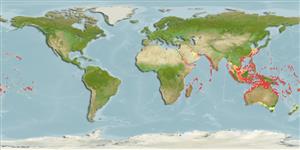Environment: milieu / climate zone / depth range / distribution range
Ekologi
laut; payau berasosiasi dengan karang; kisaran kedalaman 0 - 80 m (Ref. 9710). Tropical; 32°N - 47°S, 24°E - 140°W
Indo-Pacific: Persian Gulf (Ref. 68964), Red Sea and East Africa to the Marquesan and Easter islands, north to southern Japan and the Ogasawara Islands, south to northern Australia and Lord Howe Island; except in Hawaii, where former subspecies C. marginatus is found.
Size / Weight / umur
Maturity: Lm ? range ? - ? cm
Max length : 140 cm TL jantan/; (Ref. 90102); common length : 50.0 cm TL jantan/; (Ref. 11039)
deskripsi pendek
Kunci identifiaksi (pengenalan) | Morfologi | Morfometrik
Duri punggung (Keseluruhan (total)) : 0; Duri dubur: 0; vertebrata, bertulang belakang: 139 - 146. Flanges on upper and lower lips well developed; 2 rows of teeth in jaws, those of outer row larger; closely set and compressed to form cutting edge; 6th infraorbital pore located close behind and slightly above posterior angle of jaw. Dorsal fin begins over middle of appressed pectoral fin (Ref. 11039, refer to key for other characters). Brownish grey, yellow below and on fins, median fins with narrow black edge, black patch on lower rear edge of eye and on pectorals (Ref. 5323); assumes a pattern of broad dark bands at night (see also Ref. 4538, 1602). Body depth at gill opening 17-23 in TL (Ref. 90102).
Solitary species common on reef flats and seagrass beds of shallow lagoons but ranges to depths of 80 m on outer reef slopes (Ref. 1602). Also found in estuaries (Ref. 5213). Feeds on fish and crustaceans at night, assuming a pattern of broad dark grey bars (Ref. 11441). Minimum depth reported taken from Ref. 86942.
Life cycle and mating behavior
Kematangan | Reproduksi, perkembang biakan | Pemijahan | telur-telur | Fecundity | Larva
Smith, D.G., 1999. Congridae. Conger eels. p. 1680-1686. In K.E. Carpenter and V.H. Niem (eds.) FAO species identification guide for fishery purposes. The living marine resources of the WCP. Vol. 3. Batoid fishes, chimaeras and bony fishes part 1 (Elopidae to Linophrynidae). FAO, Rome. (Ref. 11039)
Status IUCN Red List (Ref. 130435: Version 2024-1)
ancaman kepada manusia
Harmless
penggunaan manusia
Perikanan: komersial; Ikan buruan: ya; Akuarium: Komersial
Alat, peralatan
laporan khas
muat turun XML
Sumber internet
Estimates based on models
Preferred temperature (Ref.
123201): 23.7 - 29, mean 27.7 °C (based on 1436 cells).
Phylogenetic diversity index (Ref.
82804): PD
50 = 0.5000 [Uniqueness, from 0.5 = low to 2.0 = high].
Bayesian length-weight: a=0.00060 (0.00034 - 0.00106), b=3.21 (3.06 - 3.36), in cm total length, based on LWR estimates for this species & Genus-body shape (Ref.
93245).
Trophic level (Ref.
69278): 4.3 ±0.5 se; based on diet studies.
Daya lenting (Ref.
120179): Rendah, Waktu penggandaan populasi minimum 4.5 - 14 tahun (Preliminary K or Fecundity.).
Fishing Vulnerability (Ref.
59153): Very high vulnerability (84 of 100).
Nutrients (Ref.
124155): Calcium = 22.3 [12.3, 38.1] mg/100g; Iron = 0.449 [0.264, 0.796] mg/100g; Protein = 19.1 [16.1, 22.1] %; Omega3 = 0.114 [0.052, 0.326] g/100g; Selenium = 49.9 [26.8, 95.7] μg/100g; VitaminA = 67.3 [20.5, 229.8] μg/100g; Zinc = 0.8 [0.6, 1.1] mg/100g (wet weight);
